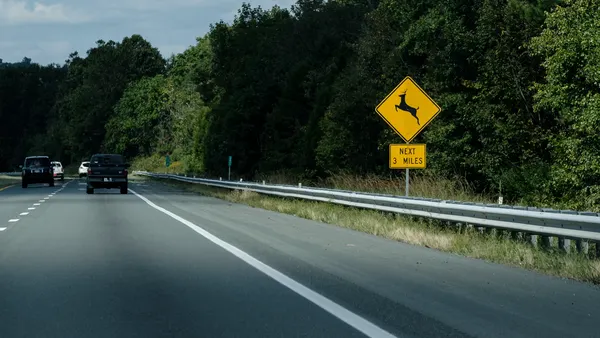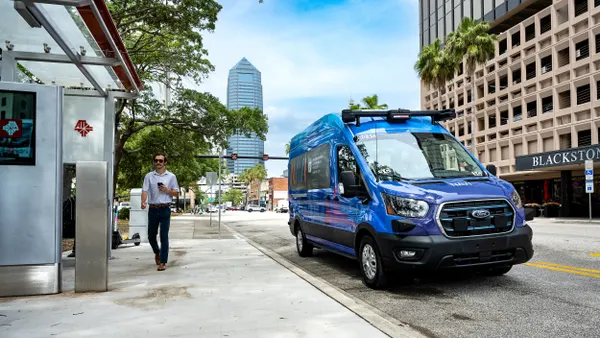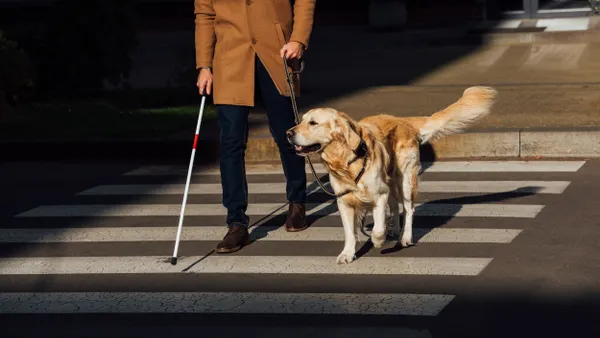Dive Brief:
- The Federal Highway Administration (FHWA) approved the optional use of red paint on city streets to signify bus priority lanes. Giving buses their own lane is intended to remove the vehicles from the rest of traffic, speeding up service and boosting reliability.
- Any jurisdiction that requests and receives approval from FHWA will be able to use the red pavement paint for bus travel lanes in designated locations and at transit stops. States may also request permission for all of their jurisdictions.
- FHWA made its decision based on approved experiments with red transit lanes as a traffic control device in Chicago; New York City; San Diego County; Santa Rosa, CA; and Washington, DC. The permissions that FHWA grants under the new regulation will be "interim" approvals because the agency's guidelines on street traffic control devices is in the process of being revised.
Dive Insight:
Numerous organizations, including the American Public Transportation Association (APTA), support the change to allow red bus lane paint.
"APTA believes in innovation, and implementing new technologies is vital to helping ensure public transit riders, pedestrians and drivers remain aware and safe - the use of different color lanes is one of those innovations," Chad Chitwood, spokesperson for the American Public Transportation Association (APTA), told Smart Cities Dive via email. "The data indicates red painted bus lanes will play a role in improving traffic moement and serve as a deterrent for bus related accidents nationwide as it is implemented.”
Cities that participated in the initial experiments also support the decision. A spokesperson for the Chicago Department of Transportation (CDOT) told Smart Cities Dive the agency welcomes the federal endorsement of bus-only lanes. CDOT announced last week that city officials would begin enforcing no stopping or standing restrictions in the red bus lanes during rush hour, which advocates view as critical for the bus lanes to serve their intended purpose of speeding up service.
FHWA points out that instances have been reported of drivers becoming confused with the red lanes and violating rules surrounding them. This has been documented in pilot cities like Chicago, where drivers said they were not sure if they could park in red bus lanes. Therefore, FHWA recommends that agencies installing red paint consider educational campaigns and signage to reduce confusion among road users, and to increase compliance.
FHWA provided guidelines for the red paint use such as the exact allowable hues; that it may be retroreflective; that it should not reduce traction for street users; and exactly where the paint may be used. "Because this colored pavement has been used to regulate, warn, or guide traffic, it is serving as more than an aesthetic treatment and is, by definition, a traffic control device," the regulation says.
The red paint brings greater attention to public transit and alerts road users to transit-only lanes. It is a similar concept to the green bike lanes that began to proliferate in the last decade, primarily at places where bikes and vehicles have to cross, such as at turns or intersections. In some cases, cities have allowed taxis and bicyclists to use the red lanes in addition to buses, and FHWA does not restrict such decisions. FHWA acknowledges that sometimes vehicles may have to enter the red transit lanes to make turns or access parking, but personal vehicles should not be in them in the majority of cases.
The policy change is notable especially because of FHWA's previous resistance to allowing cities to use anything other than the approved white striping in crosswalks. FHWA stated it does not support colored crosswalk paint as a traffic control device because it can distract drivers, therefore cities such as Ames, IA were asked to remove their creative crosswalks. Cincinnati initially held off on implementing its creative crosswalk program for that reason, but went forward with it once it was established that the designs would not be directly in crosswalks and would not serve as formal traffic control devices and thus do not violate the federal rule.











